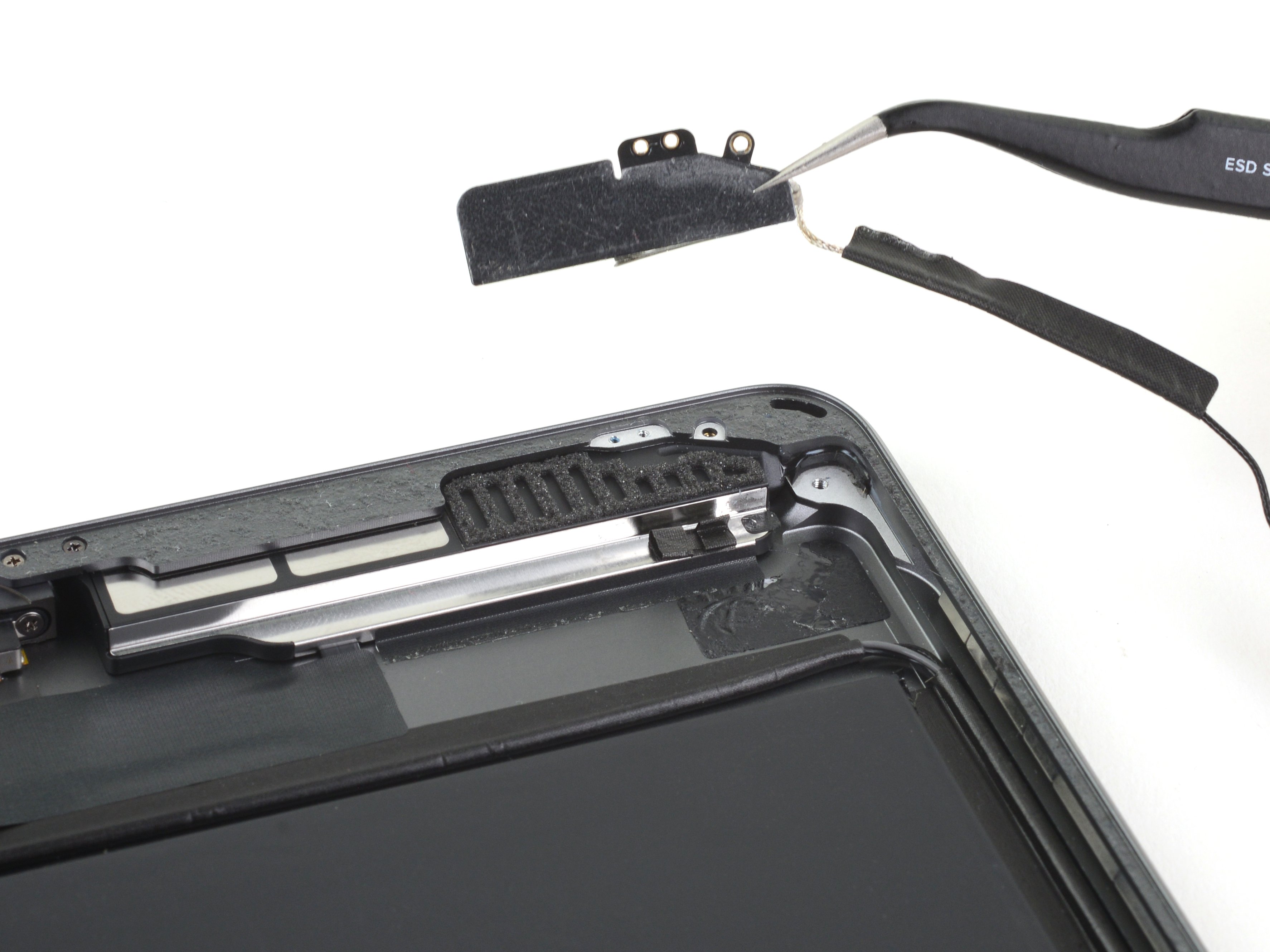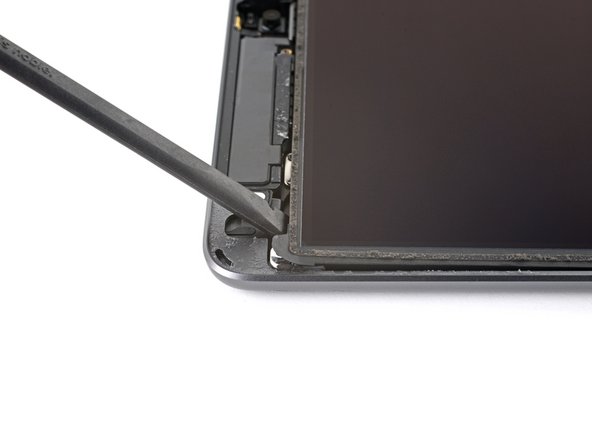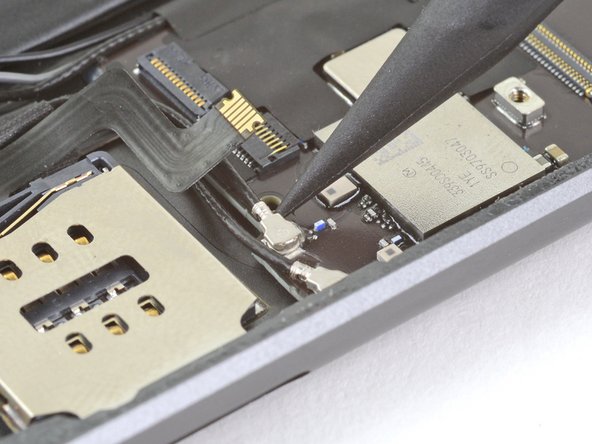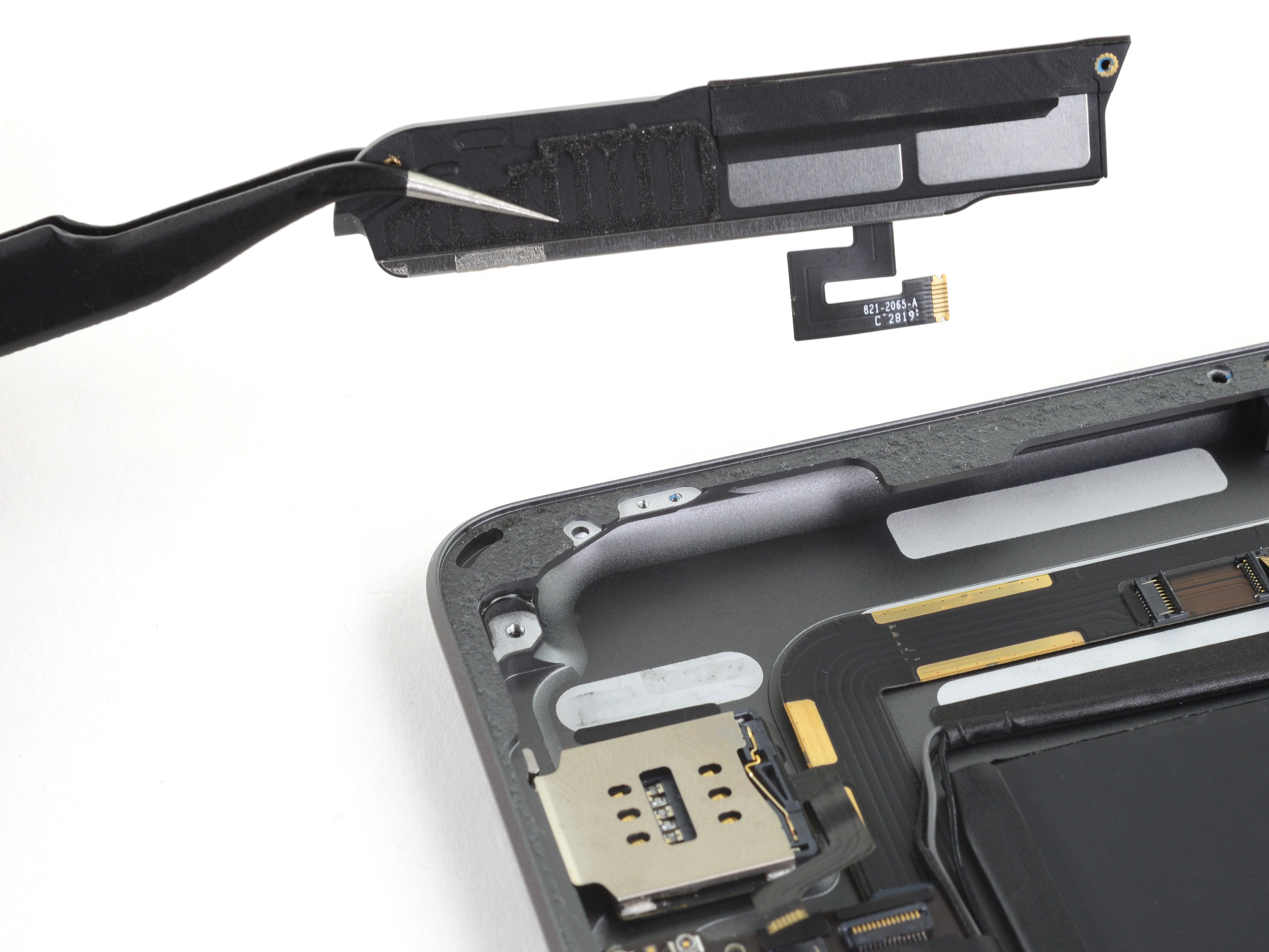iPad 9 LTE Left Bluetooth and Wi-Fi Antenna Replacement
Duration: 45 minutes
Steps: 55 Steps
Heads up! Make sure to drain your iPad’s battery down to below 25% before taking it apart—safety first!
Follow this guide to swap out the left Bluetooth and Wi-Fi antenna in your iPad 9 LTE. Heads up: this is just for the LTE model. Using the Wi-Fi version? Click here instead. For safety, make sure your battery is below 25% charge before you start taking things apart — it lowers the chance of fire if the battery gets damaged. If your battery looks swollen, take extra care. Some steps here come from a previous iPad model, so there might be tiny differences, but the overall process is pretty similar. You'll also need replacement adhesive to finish the job.
Step 1
First things first, let’s give your iPad a little break—power it down before we dive into the repair adventure!
- Warm up an iOpener and press it against the left edge of the iPad for a solid two minutes to loosen things up.
Tools Used
Step 2
- As you bide your time for the adhesive to take a breather, keep an eye out for these delicate spots that are not fans of prying:
- Front camera
- Ambient light sensors
- Antennas
- Display cables
Step 3
Get ready for a smoother opening experience! The next three steps showcase the Anti-Clamp, our handy-dandy tool designed to help you pop that device open with ease. If you don’t have an Anti-Clamp handy, no worries! Just skip down three steps for a different approach.
Want to master the art of using the Anti-Clamp? Check out our detailed guide for all the tips and tricks.
If your iPad's surface is feeling a bit too slick for the Anti-Clamp to grip, a little tape can work wonders! Just stick some on to create a better surface for a solid hold.
- Flip the blue handle back to release the Anti-Clamp's arms.
- Set something under your iPad so it stays balanced between the suction cups.
- Place the suction cups near the center of the left edge—one up top, one down low.
- Keep the bottom of the Anti-Clamp steady and press down firmly on the top cup to get a good seal.
Step 4
- Grab the blue handle and pull it forward to lock those arms in place.
- Twist the handle clockwise all the way around (360 degrees) or until you see the suction cups start to stretch out.
- Keep an eye on the suction cups — they should stay perfectly aligned. If they start to slip, just loosen them a bit, realign the arms, and you’re good to go.
Step 5
Take it easy! Only turn the Anti-Clamp a little – about half a turn at a time – and kick back for a minute between adjustments. Let that trusty Anti-Clamp and a bit of time do their magic for you.
For the full scoop on using a hair dryer, swing by this guide.
If the Anti-Clamp isn’t giving you the gap you need, just warm things up a bit more and give the handle a half turn in a clockwise direction.
- Hang tight for a minute to let the adhesive chill out and create a little opening for you.
- If the screen isn't warming up enough, feel free to whip out a hair dryer and gently warm up the left edge of the iPad.
- Slide an opening pick under the digitizer once the Anti-Clamp has made a nice enough gap for you.
- You can skip the next step!
Step 6
- When the screen feels warm to the touch, stick a suction handle on the left edge, as close to the border as you can get.
- Gently lift the screen using the suction handle to make a tiny gap between the digitizer and the frame.
- Slide an opening pick into the gap between the digitizer and the frame to start the separation.
If your screen is cracked up, try sticking a layer of clear packing tape over it to give that suction cup something to grab onto. Alternatively, you can go for some seriously strong tape as a backup if the suction cup just won't stick. And if you're really stuck, a bit of superglue can help keep that suction cup attached to the broken screen for a little extra grip. Remember, if you're feeling unsure, just schedule a repair and let the pros handle it!
Tools Used
Step 7
No need to panic if you spot the opening pick peeking through the digitizer—just pull it out gently. The LCD screen should stay safe, but be careful not to leave behind any sticky adhesive that's hard to clean.
- Pop a second opening pick into that nifty gap you just made.
- Gently slide the pick towards the bottom-left corner of the iPad to break free the adhesive.
- Keep that pick in the bottom-left corner to stop the adhesive from getting cozy again.
Step 8
- If your opening pick decides to stick to the adhesive, give it a little roll along the side of the iPad to keep that adhesive separation going strong!
Step 9
- Gently slide that first opening pick towards the top-left corner of your iPad to break free the adhesive holding it in place.
- Once you've made that move, leave the pick snug in the top-left corner to keep that adhesive from getting cozy again.
Step 10
- Warm up that iOpener and give the top edge of your iPad a cozy two-minute hug!
Tools Used
Step 11
Insert the pick no more than 7 mm deep to keep that ambient light sensor safe and sound.
- Gently twist the pick around the top-left corner of the iPad to break through the adhesive.
Step 12
Watch out for the front camera while you slide that pick around—it's a delicate little thing, and we don’t want to scratch that lens! Follow these steps to keep it safe and sound.
- Gently slide your opening pick along the top edge of the iPad, but pause just before you get to the front camera to keep things safe.
Step 13
- Gently pull the pick out so that just the tip stays tucked between the digitizer and the frame.
- Carefully slide the pick over the top of the front camera to loosen the adhesive.
- Keep the pick resting near the right side of the front camera before moving on to the next step.
Step 14
- Slide that pick back in and nudge it towards the top-right corner of your iPad to fully break free the top adhesive. You're almost there!
- Keep that pick snug in the top-right corner to stop the adhesive from being a party crasher and re-sealing.
Step 15
- Warm up your iOpener and let it cozy up against the right edge of your iPad for a good two minutes.
Tools Used
Step 16
Be sure to only slide that pick in up to 4 mm to keep the ambient light sensor safe and sound!
- Gently twist the pick around the top-right corner of your iPad to loosen the adhesive. Take it slow and steady, and you'll be through in no time!
Step 17
The display cables hang out about halfway up from the bottom of your iPad. Slide carefully and stop once you’re about three inches from the bottom to avoid any surprises.
- Grab your trusty opening pick and gently slide it right into the heart of the iPad's right edge. You're almost there!
Step 18
- Warm up an iOpener and stick it onto the bottom edge of the iPad for a solid two minutes to get things nice and toasty.
Tools Used
Step 19
Avoid spinning the pick all the way around the corner — the antenna’s delicate, and we want to keep it happy!
Check out the third image to spot the bottom-left antenna hanging out beneath the digitizer.
- Gently slide that bottom-left pick into the corner to break the adhesive's hold. You're doing great!
- Keep that pick snug in the corner while you get ready for the next move. You're on a roll!
Step 20
Just a friendly reminder: slide that pick gently toward the home button, not away, to avoid any antanna-tastrophes!
If you need to glide the pick over this spot again, just pull it out and pop it back in at the bottom-left corner.
- Pop a new opening pick into the gap you just made along the bottom edge of the iPad.
- Gently slide the pick past the antenna, stopping right before you reach the home button.
- Leave the pick resting to the left of the home button before moving on to the next step.
Step 21
- Gently slide an opening pick into the little gap you've just created—think of it as a door to a secret world!
- Now, let's slide that pick right underneath the home button and glide it towards the bottom-right corner. Just the tip should be nestled between the digitizer and the frame. You've got this!
Step 22
Remember to gently slide the pick toward the home button – pushing it the other way could put a dent in your antenna's day!
If you find yourself needing to give that pick another slide over this spot, just lift it out and pop it back in at the bottom-right corner.
- Slide the pick back in and gently nudge it towards the home button to fully break free the bottom adhesive. You're almost there!
- Once you've got that pick in place, just leave it to the right of the home button before moving on. Keep up the great work!
Step 23
- Warm up an iOpener and place it on the right edge of the iPad for a solid two minutes to loosen things up.
Tools Used
Step 24
Take it slow and steady here. Make sure your adhesive is nice and warm, so it’s easy to separate. Use your opening pick to carefully slide through all the adhesive. Don’t hesitate to pause and warm it up again if needed!
If you're feeling some serious resistance, don't panic! Just heat up those edges a bit more and gently glide along with an opening pick like you're dancing through a sweet groove.
- Gently twist the two opening picks on the left corners of your iPad. This will lift the digitizer just a bit, letting go of the last bits of adhesive along the way.
Step 25
- Gently lift the left edge of the digitizer to help peel away the adhesive that’s sticking to the right side of your iPad. You've got this!
Step 26
Watch out for those two display cables! Your opening pick might be sneaky, so keep a steady hand and don’t let them get caught in the action.
- Gently support the digitizer while sliding an opening pick between the two display cables. This will help you separate the remaining adhesive with ease.
Step 27
- Once you've got all that sticky stuff out of the way, gently open the digitizer like a book and lay it down next to the iPad.
- When putting everything back together, make sure to wipe off any leftover adhesive from the frame—and from the digitizer if you're reusing it—with some isopropyl alcohol. Replace the adhesive using our handy adhesive strips or pre-cut adhesive cards.
- Keep an eye on those display cables while you're reassembling the iPad. Make sure they’re tucked neatly beneath the LCD screen to avoid any mishaps.
Step 28
- Grab some tweezers or just use your fingers to peel away any tape hiding those LCD screws. Easy does it!
Tools Used
Step 29
- Grab a Phillips #00 screwdriver and unscrew the four 4.2mm screws holding the LCD screen in place. Keep those screws safe—you’ll need them in just a sec!
Tools Used
Step 30
The LCD is gently sticking to the frame, so it should come off without too much fuss. Just give it a little nudge, and you'll be good to go!
- Gently slide a spudger in between the frame and the top-right corner of the LCD.
- Carefully wiggle the spudger to loosen the adhesive bit by bit.
Tools Used
Step 31
- Now, go ahead and do the same thing for the top-left corner of the LCD. You got this!
Step 32
Be careful not to fully detach the LCD just yet! It's still holding on by a flex cable, so give it some time before fully removing it.
- Grab your spudger and gently pry the LCD out of its cozy little home. Just enough to get a good grip with your fingers, no need to go overboard.
- Now, treat the LCD like a page in a book. Flip it over near the camera, and carefully turn it towards the home button end of the frame. Easy does it!
- Place your LCD on a soft, clean, and lint-free surface so you can easily access those display cables. No mess, no stress.
Tools Used
Step 33
- Grab your trusty Phillips screwdriver and carefully take out the 2.3 mm-long screw that's holding the battery connector snugly against the logic board. You've got this!
Step 34
Take a look at these photos to get a clear idea of what the battery connector looks like under the logic board. Use them as your guide when you carefully disconnect the battery.
You'll notice that the battery connector has these little cantilever springs on the logic board that press against the battery contact pads. Since both the logic board and battery are stuck down, you'll need something thin and flexible to slide between the contact points to safely disconnect the battery.
Step 35
Watch out when you're isolating the battery with a battery blocker! Those battery contacts can be a bit flimsy and may bend or break, leading to some seriously tough situations. Stay sharp and handle with care!
Make sure the logo on the battery blocker is facing upward—no upside-down surprises here.
Avoid shoving the battery blocker under the connector with too much force. If it’s being stubborn, try gently sliding a playing card underneath to disconnect the battery instead.
The battery blocker or playing card should glide under the logic board smoothly, without any obstacles. Once in place, it should sit at roughly a 15-degree angle.
- Gently slide that battery blocker right under the logic board's battery connector, angling it at about 35 degrees—like you're giving it a little high-five!
- Once it's snug in place, let it hang out while you tackle the rest of the repair. It's got your back!
Tools Used
Step 36
- Grab your trusty Phillips screwdriver and let's get to work! Start by unscrewing those three little 1.4 mm-long screws that are keeping the display cable bracket in place. You've got this!
Step 37
- Pop off that display cable bracket! It’s a simple step, but it’ll open up a lot of space for the next moves. Just give it a gentle nudge and you're good to go!
Step 38
- Gently use the flat end of a spudger to lift and unplug the LCD cable press connector.
- When reconnecting press connectors like this, line up one side carefully and press down until you hear a click, then do the same on the other side. Avoid pressing the middle—if things get crooked, the pins might bend and that’s a no-go.
Tools Used
Step 39
- Carefully take out that LCD and place it face down on a clean, soft surface that won’t leave any lint behind. Treat it like the precious gem it is!
Step 40
- Grab a trusty pair of tweezers and gently lift off the tape that's guarding the home button cable ZIF connector. You've got this!
Tools Used
Step 41
- Grab a spudger, an opening tool, or even your fingernail to gently flip up the tiny hinged locking flap on the home button cable ZIF connector. Easy does it!
Tools Used
Step 42
- Grab a pair of tweezers and gently pull the home button ribbon cable straight out of the ZIF connector. Take it slow, no rush—this step’s all about finesse!
Tools Used
Step 43
Be gentle and only pry at the connectors themselves—avoid poking the socket on the logic board to keep your iPad safe and sound.
- Gently slide the flat end of a spudger under the two digitizer cable press connectors and pop them loose with care.
Tools Used
Step 44
Be super careful not to poke or rip the home button ribbon cable! It's more delicate than it looks!
- Grab your spudger and gently slide the flat end under the buffer block, which is chilling near the bottom-right corner of the iPad.
- Once you've got it lifted, go ahead and remove the buffer block.
Tools Used
Step 45
The home button cable is held in place with just a little bit of adhesive. It’s not too tricky to detach, just give it a gentle nudge!
- Grab your tweezers and gently lift the home button cable off the frame. Take it slow, you got this!
Tools Used
Step 46
Grab an opening pick and gently cut through any leftover adhesive that might still be holding the front panel assembly to the frame. You got this!
Without proper insulation, those parts of the digitizer can get a little too cozy with other components, leading to touch input issues. Not cool, right?
The insulation is super stealthy—it's practically invisible to the naked eye and way different from the foam dust barrier strips that you'll see on many iPads.
- Take off the front panel assembly carefully.
- If you notice any weird "ghost" or "phantom" touches on your new display, don’t panic! You can fix this by placing a super thin layer of insulating tape, like Kapton (polyimide) tape, on the highlighted spots on the back of the panel. Replacement digitizers already come with the right insulation, so usually no extra tape is needed.
- When putting everything back together, make sure to remove any leftover adhesive from the iPad. Clean the sticky areas using high concentration isopropyl alcohol (90% or higher) and a lint-free cloth. This step is key to getting fresh adhesive to stick properly.
- Give your iPad a test run to make sure everything works, then stick on the pre-cut adhesive strips to the back of the display following the display adhesive application guide before sealing it up.
Step 47
- Gently use the tip of a spudger, an opening tool, or even your trusty fingernail to lift that small, hinged locking flap on the SIM card reader cable ZIF connector. You're doing great – just a little flip and you're on your way!
Tools Used
Step 48
- Grab a trusty pair of tweezers and gently wiggle that SIM card reader cable out of the ZIF connector. You've got this!
Tools Used
Step 49
There are two antenna cables in this area, but you're only going to unplug the one that's the furthest from the edge. You've got this!
- Slide the pointy end of your spudger under the left antenna cable and gently lift it straight up to unplug it.
Tools Used
Step 50
Hold onto the antenna cable by its body, not the connector. Tugging on coaxial cables by their connectors can lead to breakage. Keep it cool and gentle, and you'll be just fine!
The tape holding down the left antenna cable is hiding under the tape for the right antenna cable. If you're finding it tricky, go ahead and disconnect and peel back the right antenna cable for a little extra room.
- Gently lift the left antenna cable away from the back of the case.
Step 51
- Gently peel the left antenna cable away from the rear case, following the bottom edge of the iPad. Take your time, and be careful not to tug too hard!
Step 53
- Grab your trusty Phillips screwdriver and unscrew the three screws holding down the left antenna. You’ve got this!
- One screw that's 2.3 mm long
- Two screws that are 1.4 mm long
Step 54
The antenna cable is held in place on the speaker by a tiny metal bracket that's crimped tight and stuck down with adhesive. To get that antenna out, you'll need to carefully cut through the glue holding it to the speaker enclosure.
- Gently slide an opening pick between the speaker enclosure and the bracket—think of it as a tiny door opener.
- Carefully work the pick toward the charging port to slice through the adhesive holding things together.
- Nudge the bracket away from the speaker so it’s free and clear of the tape lurking underneath.
Step 55
- Put your device back together by following these steps in reverse order.
- Remember to recycle your e-waste responsibly at an R2 or e-Stewards certified recycler.
- If things didn’t go quite as expected, try some basic troubleshooting or reach out to our iPad 8 Answers community for tips.
- And if you find yourself stuck, you can always schedule a repair with us!




















































































































































